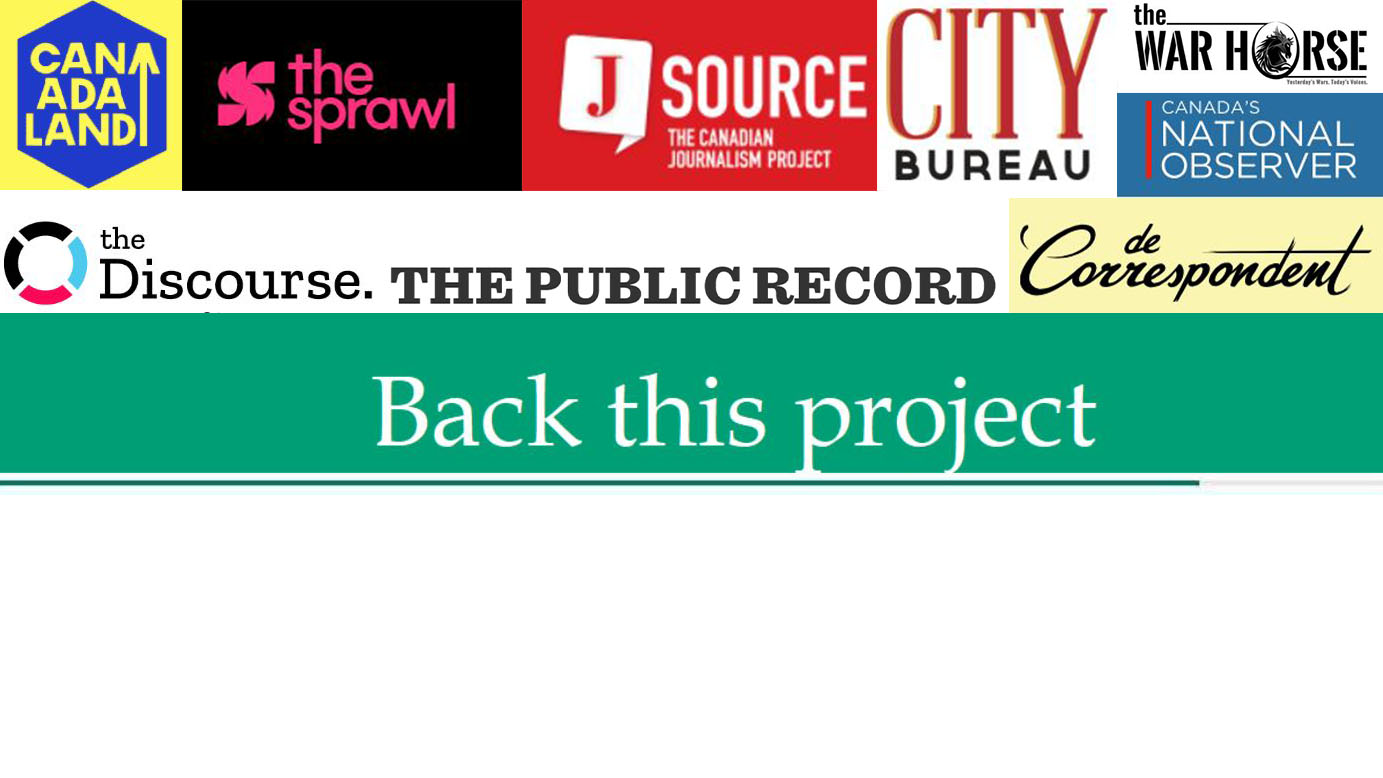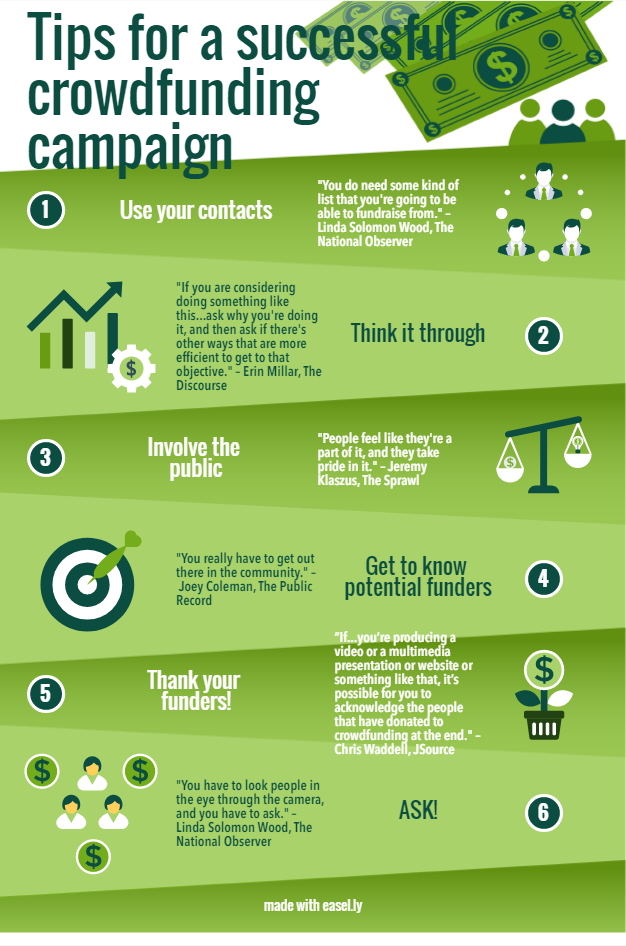Crowdfunding: the new way forward?

Crowdfunding is increasingly popular with news outlets across Canada
Linda Solomon Wood was at first reluctant to turn to crowdfunding.
Launching a crowdfunding campaign required all of her attention and involved doing something she, like many others, was uncomfortable with: asking others for money.
In 2013, Wood wanted to do more in-depth reporting on the oil sands in Western Canada. She turned to crowdfunding on Kickstarter, which had just launched in Canada, to fund that reporting. Her first crowdfunding campaign was launched in 2014 and allowed the Vancouver Observer to launch on a national scale as the National Observer. The National Observer has since funded three more campaigns worth $169,627 total on Kickstarter.
Wood is passionate about climate change and the environment, and Kickstarter helped connect Wood and her team to people from all over the world who were also passionate about the same thing – people that Wood otherwise may not have reached. Wood says that at the time, she “could not have found the money… any other way.”
Crowdfunding typically raises small amounts of money from a large number of people. Websites like Patreon and Kickstarter are platforms used to raise funds for causes ranging from personal medical emergencies to start-up businesses. Crowdfunding allows news outlets to do deeper dives into specific issues, like the National Observer’s Reports from the Energy Battlegrounds campaign of 2015. It’s also a way for readers to get directly involved with news media and contribute to the coverage of issues they are passionate about.
One of the most popular crowdfunding websites, Kickstarter, launched in 2009 and has helped users raise over $3.9 billion Canadian dollars from 15 million backers. Some crowdfunding websites are used for one-time or recurring pledges while some, like FrontFundr, allow supporters to become investors and own shares of the companies they support. Crowdfunding platforms are free to use, so no money is required upfront to use their services, though the services do take some campaign proceeds for operating and transaction fees.
The impact
In her 2011 study The Impact of Crowdfunding on Journalism, Stanford University postdoctoral research fellow Tanja Aitamurto said crowdfunding is a way for journalists to accurately gauge which stories are important to the public. As donors, the public gets “to define which pitches succeed, and thus, which stories will be reported upon.”
Aitamurto’s study also says that seeing the public donate to and engage with a campaign boosts a reporter’s motivation and gives them a stronger sense of responsibility to get their stories right.
Journalists interviewed as part of the study expressed that by using crowdfunding, they were writing for the community, and not just an editor.
Jeremy Klaszus, editor of pop-up news outlet the Sprawl in Calgary, agrees with that sentiment. “That’s the beauty of crowdfunding, is that you’re serving and you’re accountable to the people in your community.”
Why crowdfunding?
The Sprawl was founded by Klaszus in 2017. Each edition of the Sprawl covers one specific issue, followed by a quiet period until the next issue, hence the ‘pop-up’ designation. Klaszus chose crowdfunding because he’s “not a salesperson,” and found it easier to approach Calgarians who knew him as a journalist, as opposed to investors. The Sprawl has over 500 supporters on Patreon.
Chris Waddell, publisher of J-Source, based at Carleton University in Ottawa, says the goal of J-Source is for people from all over the country to be able to keep up with the media and journalism industry in their area. To do this, Waddell wanted to commission stories from freelancers scattered across the country. He could not do that “if we weren’t prepared to give them a little bit of money for their work.”
J-Source has paid $100-200 for freelance articles thanks to funds raised from their Patreon platform, though Waddell would “like it to be more money.” Waddell plans to expand J-Source’s crowdfunding campaigns in the future to make that happen and increase the number of regular contributors to the publication.
Pros and cons
It takes time to make a crowdfunding campaign successful. A campaign is not launched on a whim – it takes planning and patience. Most of the planning involves deciding how to promote the campaign, from which platform to use to what promotional materials would best suit that particular campaign.
Awareness must be raised before the campaign even launches, to capture interest – having something like an email list to communicate your ideas to potential backers. Research must be done, to determine the full cost of the project. “You don’t want to be in a situation where you’re successful but it’s only half of what you really need,” says Wood.
There are legal regulations that must be followed as well, particularly with equity-based campaigns such as the Discourse’s, a start-up media outlet based in Vancouver. Erin Millar, the founder and CEO of the Discourse says it’s “actually a pretty legally complex form of financing to do nationally.” In equity-based campaigns, supporters become shareholders in the companies they support. In campaigns like these, more money is spent on legal and accounting as a higher level of disclosure is needed.
Millar says the support behind her crowdfunding campaign allowed her to “make the case that people do support this idea” to more traditional investors, who also back the Discourse.
The planning and preparation of a crowdfunding campaign can take an emotional toll. Wood’s last campaign, Race Against Climate Change, “was exhilarating as usual, but I really felt unbelievably exhausted by the end of it.”
Waddell describes the process as “pretty chaotic” and time-consuming, and it can be challenging to get people to contribute.
It’s not all stress and intensive work, though. Seeing a campaign become successful can be reaffirming to journalists who run them. Wood, at the National Observer, was touched that supporters “believed in our ability to execute this project and to have an impact. The readers cared, people cared.”
Klaszus feels the same way. “None of the Sprawl’s stuff is under a paywall, you don’t need to become a supporter to read or listen to anything the Sprawl does… but people still sign up because they believe in it and they identify with it.”
Joey Coleman, the editor of Hamilton, Ontario’s the Public Record, believes that local journalism and crowdfunding both are rewarding for those who pursue them. As a local journalist supported by local citizens, Coleman has the “enjoyment of walking down the street and people coming up and shaking my hand and saying ‘thank you for your work’,” a kind of recognition he didn’t get while reporting on the national level.

After crowdfunding
There is a great deal of optimism surrounding the future of crowdfunding in journalism. Klaszus has “no plans to change that core model at all” at the Sprawl, as crowdfunding allows the locals to engage with and take pride in their media outlets.
Coleman, at the Public Record, is adamant that “the future of journalism is going to be at the reader-funded level, at least locally.”
While crowdfunding works well with particular business models, it isn’t a sustainable model for every outlet. Just nine months after launch, the National Observer put up a paywall and switched to a common subscription-based method.
Back at the National Observer, Wood said that with crowdfunding, they “were getting people to pay for the journalism, and so I decided that we were going to put up a paywall… The subscription model is truly an ongoing crowdfunding campaign, in my mind.”

